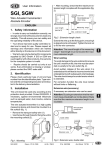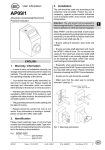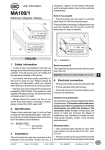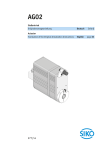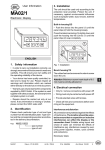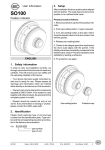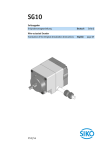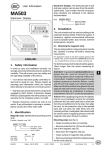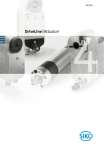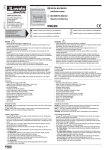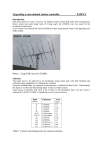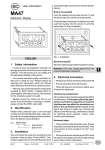Download GP43, GP44, GP63, GP64 user manual
Transcript
User Information 3. Summary description The geared potentiometers are of very robust design and compact size. GP43/44/63/64 Geared Potentiometer With Limit Switches GP43/63 GP44/64 The gear mechanism / potentiometer combination adapts the mechanical rotating angle of the 1 or 10-turn potentiometer to the measuring range. A slipping clutch between the gear mechanism and the potentiometer prevents irreparable mechanical damage to the potentiometer, if the end stop is overtravelled (only valid for 10turn potentiometer; 1-turn potentiometers do not have an end stop). The geared potentiometers GP63/64 is equipped with an R-I transformer. The resistance values relating to the potentiometer position are converted into a loop current in the range 4 to 20 mA. This allows a measuring value transmission independently from the transmission line's resistance. Max. 3 trip control 3 switching actions. ENGLISH 4. Warranty information Please handle the encoder carefully as it is a high-precision device. 1. Safety information In order to carry out installation correctly, we strongly recommend this document is read very carefully. This will ensure your own safety and the operating reliability of the device. • Your device has been quality controlled, tested and is ready for use. Please respect all warnings and information which are marked either directly on the device or in this document. • Warranty can only be claimed for components supplied by SIKO GmbH. If the system is used together with other products, the warranty for the complete system is invalid. • Repairs should be carried out only at our works. If any information is missing or unclear, please contact the SIKO sales staff. Especially do not: • disassemble or open the encoder (unless stipulated in this brochure). • link encoder's shaft with rigid couplings as this would expose the encoder's shaft bearing to high forces. For solid shaft encoders we recommend the use of SIKO flexible shaft coupling type AK18. • knock the housing and the shaft, because this will damage the encoder or internal parts. • machine (bore, mill ...) flange or shaft. This could lead to severe damage inside the encoder. • exceed the values for the maximum axial and radial shaft load. 2. Identification • mount the encoder incorrectly. Please check particular type of unit and type number from the identification plate. Type number and the corresponding execution are indicated in the delivery documentation. Otherwise manufacturer's warranty will be invalidated! e.g. GP43-0023 type number type of unit GP43/44/63/64 Datum 31.01.2000 Art.Nr. 79804 Z.Nr. 8604015 Änd.Stand 462/99 7 NEVER ... choice of cable can minimise the effects of interference (eg. interference caused by switching power supplies, motors, cyclic controls and contactors). Necessary steps: • Only screened cable should be used. Screen should be connected to earth at both ends. Wire cross section is to be at least 0,14 mm2, max. 0,5 mm2. • Wiring to screen and to ground (0V) must be via a good earth point having a large surface area for minimum impedance. • The unit should be positioned well away from cables with interference; if necessary a protective screen or metal housing must be provided. The running of wiring parallel to the mains supply should be avoided. 5. Installation The unit should be used only according to the protection level provided. Protect the unit, if necessary, against environmental influences such as sprayed water, dust, knocks, extreme temperatures. Mounting of the encoder • Contactor coils must be linked with spark suppression. Supply voltage of the instrument transformer Operating voltage depends on execution and is indicated in the delivery documentation or on the identification plate. • Use the frontal bores to fix the encoder. Mount encoder without force. 20 ... 28 VDC • Forces must not be transmitted via the housing, but only via the shaft. 6.1 How to open and close the device • Do not exceed the values for the maximum axial and radial shaft load. • To open the unit, remove fastening screws on the GP44/64's cap (on GP43/63's back wall). • Ensure accurate shaft alignment. If shaft and flange are not correctly aligned, strain on the bearings will result, which will overheat and be irreparably damaged. • Ensure that the sealing is not damaged or lost. 6. Electrical connection • Switch power off before any plug is inserted or removed !! • Wiring must only be carried out with power off. • Provide standed wires with ferrules. • Check all lines and connections before switching on the equipment. For opening: For closing: To easily close the unit and to avoid cable damage, we recommend securing the inner strands with an adhesive tape. The adhesive tape should be insensitive to temperature and ageing (only GP44/64): • Ensure that the sealing lies correctly in the groove. • Put the cap/back wall onto the flange. Do not damage the sealing. • Tighten the fastening screws. Interference and distortion All connections are protected against the effects of interference. The location should be selected to ensure that no capacitive or inductive interferences can affect the encoder or the connection lines! Suitable wiring layout and 8 GP43/44/63/64 Datum 31.01.2000 Art.Nr. 79804 Z.Nr. 8604015 Änd.Stand 462/99 Adhesive tape Fig. 3 : Cable connection PG7 Fig. 1 : Fixation of ferrules With PG9 (fig. 4) : 6.2 Cable connection • Prepare wire accord. to fig. 2 • Open the device (see chapter 6.1) and unscrew the PG-screws. Potentiometer/transducer *Cam switch • Push nut+gasket (1), washer (2) (inner-ø > washer's inner-ø (4)) and washer (4) onto the cable. • Put the wire screening (3) over the washer's (2) outer surface. • Push strands through the screw hole (5). Insert parts (4), (3) and (2) into the screw hole (5). GP43/63 Ferrule • Fix nut (1) and then fix the complete PG-screw to the casing. Shrink sleeve Wire cross section : 2 - 2x0.25mm or 3x0.25mm2 - *max. 7x0.5mm2 (number of cams x 2) +1 GP44/64 Ferrule Shrink sleeve Fig. 2 : Cable preparation Fig. 4 : Cable connection PG9 With PG7 (fig. 3) : • Push the nut (1) and the plastic bushing (2) onto the cable. • Connect strands to the clip terminals (fig. 5 and 6). • Put the wire screening (3) over the plastic bushing (2). • Close the geared potentiometer (see chapter 6.1). • Slide strands through screw hole (4). Insert plastic bushing (2) into the screw fitting. Potentiometer • Fix nut (1) and then fix the complete PG-screw to the casing. Trip cams Fig. 5 : Pin connection GP43/44 GP43/44/63/64 Datum 31.01.2000 Art.Nr. 79804 Z.Nr. 8604015 Änd.Stand 462/99 9 7.3 Adjustment of the trip cams Output transducer Ex works the trip cams are not fixed radially to the shaft. Adjustment is made after installation. Important information! Do not touch the roller levers during trip cam adjustment: damage from bending may result. Trip cams Fig. 6 : Pin connection GP63/64 with Instrument transformer • Bring the turnable trip cams (A, B, C) into a position which is favorable for fine adjustment: grub screw (1) and screw (2) must be easily accessible. 7. Adjustment and alignment • Fix the grub screws (1) to prevent straining of the trip cams. • The setting screw (2) is used for precise setting of the trip cam; use a screw driver size 3 (see fig. 8). 7.1 General information Definition of the counting directions: Hexagon socket 1,5 Fig. 7 : Definition of the counting directions For GP43/44: By direction of rotation "i" and turn the shaft in direction "e" up to the limit stop, the value of the moving contact (S) and the start point (Po) value are 0 Ohm. The value increases – related to Po – with clockwise rotation "i". Screw driver 3 Fig. 8 : Trip cam adjustment By direction of rotation "e" and turn the shaft in direction "i" up to the limit stop, the value of the moving contact (S) and the start point (Po) value are 0 Ohm. The value increases – related to Po – with anti-clockwise rotation "e". For GP63/64: ...the same as for GP43/44, but the current of the transducer starts at low values and increases towards the end point (see also chapter 7.4). 7.2 Potentiometer setting When correctly connected and switched on, the unit displays the current actual value. Fig. 9 : Nomogram: Load rating cam switches 7.4 Alignment of the instrument transformer (only for GP63/64) The unit GP63/64 comprises a resistance current converter. The potentiometer's resistance is converted into a current of 4 ... 20mA (twin- 10 GP43/44/63/64 Datum 31.01.2000 Art.Nr. 79804 Z.Nr. 8604015 Änd.Stand 462/99 core cable). The measuring current is also used for feeding the instrument transformer. 7.5 What to do if... (Instrument transformer) The instrument transformer is preset to standard values 4mA for potentiometer's start position (Po) and 20mA for end position (Pe). Via two trimmpotentiometer's Po and Pe (see fig. 6) these values can be adjusted to the application's actual start and end position: You can: • either mechanically change the counting direction (by ordering / modifiying the counting direction at SIKO), Alignment: • Trimmpotentiometer's Po is used to adjust a current of 4 mA to potentiometer values of 0 to 15% of the total range. ...the counting direction is wrong? • or by inverted interpretation of the 4 to 20 mA current (4 mA would then correspond to the end position; can be achieved via software programming). ... if the instrument transformer's start / end value cannot be set to 4 / 20 mA? • Trimmpotentiometer's Pe is used to adjust a current of 20 mA to potentiometer values of 90 to 100% of the total range. • the potentiometer's setting range is perhaps to small. The smallest available potentiometer range, in which 4 to 20 mA are delivered, is hence 15% to 90% of the potentiometer's resistance range. • check, whether you can do with a smaller current range; otherwise adjust the gear's input ratio accordingly ( by ordering / changing the counting direction at SIKO). Alignment What to do if... (Potentiometer) 1) Move axis to start position. ... an undefined value is displayed? • Carry out re-alignment or precise alignment. Undefined values can be caused by cable breaks. 2) Turn left potentiometer (Po) until start value (4mA) is measured. 3) Move axis to end position. 8. Starting 4) Turn right potentiometer (Pe) until end value (20mA) is measured. Please ensure that the instructions given in chapter 5 and 6 regarding mechanical and electrical connection are followed. This will ensure correct installation and the operating reliability of the device. The steps 1 to 4 are to be repeated until the values are counterbalanced. Before starting check again: Current • correct polarity of the supply voltage (Pe) 20mA • correct cable connection • correct mounting of the device 4mA (Po) 0 Distance Fig. 10 : Alignment GP43/44/63/64 Datum 31.01.2000 Art.Nr. 79804 Z.Nr. 8604015 Änd.Stand 462/99 11 SIKO GmbH DR.-ING. G. WANDRES Postanschrift / Postal address: Postfach 1106 D-79195 Kirchzarten Werk / Factory: Weihermattenweg 2 D-79256 Buchenbach Telefon / Phone 0 76 61 / 3 94 - 0 Telefax / Fax 0 76 61 / 3 94 - 388 Internet www.siko.de 12 GP43/44/63/64 Datum 31.01.2000 Art.Nr. 79804 Z.Nr. 8604015 Änd.Stand 462/99






